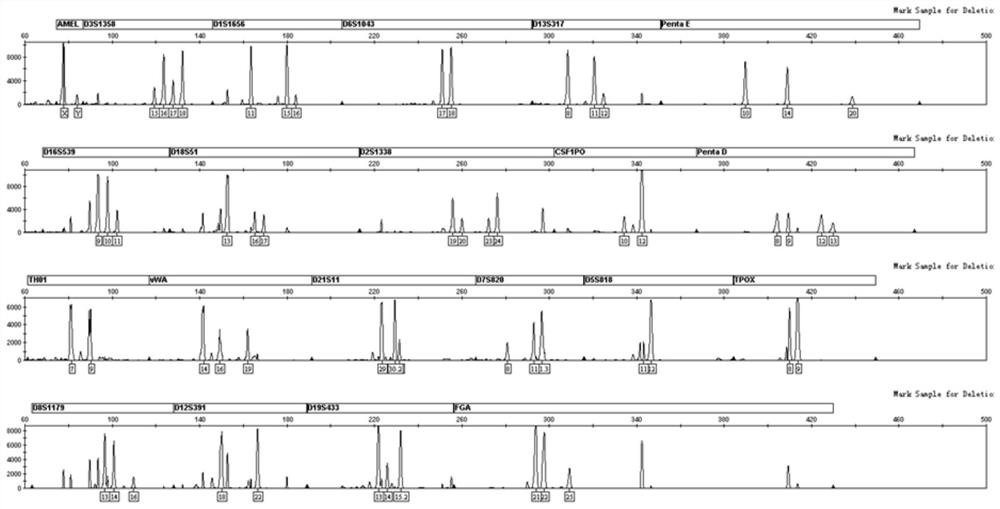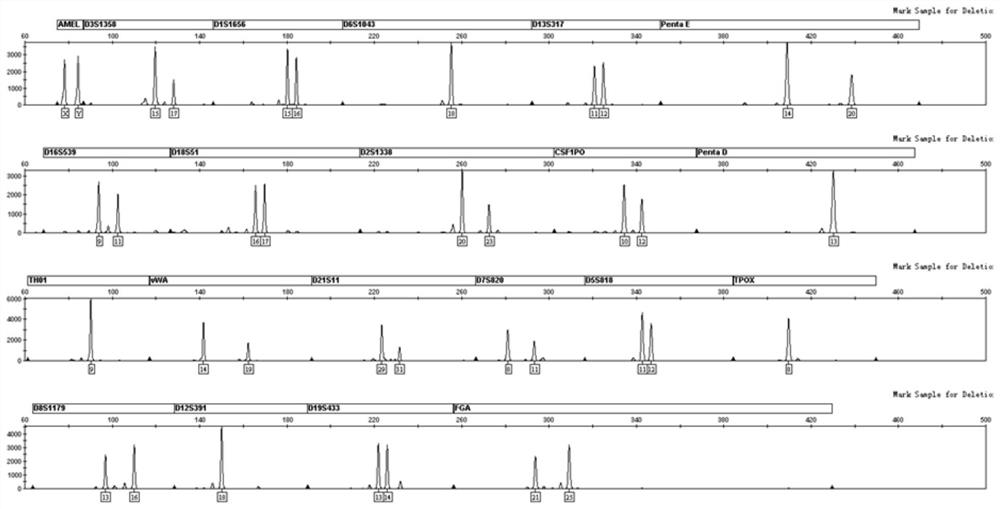Method for realizing sperm cell separation of mixed spot sample based on polypeptide modified membrane
A technology for sperm cells and modified membranes, which is applied in the field of sperm cell separation from mixed plaque samples based on polypeptide modified membranes. , to achieve the effect of suitable for large-scale promotion and application, ingenious design, and rapid separation
- Summary
- Abstract
- Description
- Claims
- Application Information
AI Technical Summary
Problems solved by technology
Method used
Image
Examples
Embodiment 1
[0044] Example 1 DNA Extraction of Mixed Spot Males Using Poly(ε-Lysine) Physically Modified Nitrocellulose Membranes
[0045] Spray or soak the poly(ε-lysine) solution on the nitrocellulose membrane to make a layer of poly(ε-lysine) adsorb on the surface of the nitrocellulose membrane, dry it in a vacuum oven at 50°C to 100°C for 4h, press the sleeve The inner tube of the tube is cut to size and fitted to the inner tube for use.
[0046] Use 200 μL to 10 mL of epithelial cell digestion solution (containing 5% by weight to 20% by weight trishydroxymethylaminomethane, 0.5% by weight to 10% by weight of sodium chloride, 1% by weight to 10% by weight of Disodium ethylenediamine tetraacetate and 10 μL ~ 100 μL of proteinase K at a concentration of 10 mg / mL) for digestion, transfer the digested product containing sperm cells and other impurities to the above-mentioned separation sleeve, let it stand for 20 minutes, and use it if necessary Shaking, overturning and other methods pro...
Embodiment 2
[0050] Example 2 Polypropylene membrane covalently modified with polyaspartic acid for DNA extraction of mixed plaque males
[0051] Pre-spray or soak 5% to 40% by weight of dopamine and 0.5% to 20% by weight of aminosilane coupling agent solution on the polypropylene film, and pass through alkaline (pH 8 ~ 12) and heating (50 ° C ~ 100°C) to modify the surface of the polypropylene film with a transition layer modified by polydopamine and aminosilane coupling agent, and then use 1-(3-dimethylaminopropyl)-3-ethylcarbodiimide salt Hydroxysuccinimide (EDC) / N-hydroxysuccinimide (NHS) method covalently coupled polyaspartic acid, after washing and drying in a vacuum oven at 50°C to 100°C for 4 hours, press the 24-well plate (including the inner plate) The size of the inner frame tube of the frame and the outer frame) is cut and assembled for use, and the number of membrane assemblies can be selected according to the number of mixed spot test materials (1 to 24).
[0052] Mix the mi...
Embodiment 3
[0056] Example 3 Use polyglutamic acid-modified carbonate microporous grooves for mixed spot male DNA extraction
[0057] Spray or soak 5% by weight to 40% by weight of dopamine and 0.5% by weight to 20% by weight of aminosilane coupling agent solution on the carbonate microporous groove, and pass through alkaline (pH 8~12) and heating (50 ℃~100℃) to modify the surface of the carbonate microporous groove with a transition layer modified by polydopamine and aminosilane coupling agent, and then use 1-(3-dimethylaminopropyl)-3-ethyl Carbodiimide hydrochloride (EDC) / N-hydroxysuccinimide (NHS) method covalently coupled polyglutamic acid, washed and dried in a vacuum oven at 50°C to 100°C for 4 hours before use.
[0058] The mixed spot sample material to be separated in Example 1 was mixed with 200 μL-10mL epithelial cell digestion solution (containing 5% by weight to 20% by weight trishydroxymethylaminomethane, 0.5% by weight to 10% by weight sodium chloride, 1% by weight ~10% by ...
PUM
 Login to View More
Login to View More Abstract
Description
Claims
Application Information
 Login to View More
Login to View More - R&D
- Intellectual Property
- Life Sciences
- Materials
- Tech Scout
- Unparalleled Data Quality
- Higher Quality Content
- 60% Fewer Hallucinations
Browse by: Latest US Patents, China's latest patents, Technical Efficacy Thesaurus, Application Domain, Technology Topic, Popular Technical Reports.
© 2025 PatSnap. All rights reserved.Legal|Privacy policy|Modern Slavery Act Transparency Statement|Sitemap|About US| Contact US: help@patsnap.com



